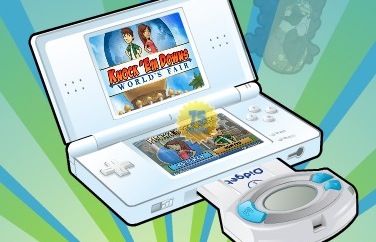Hey, boys and girls, let’s all play with our data!
 Tuesday, May 4, 2010 at 3:18PM
Tuesday, May 4, 2010 at 3:18PM Playing the Game of (Your) Life, Revisited
I wrote a while back about the prospect of your life becoming a game. Jessie Schell gave a talk in which he connected the future of electronics (ever cheaper and smaller) to all the mundane tasks in our lives, bringing about a whole new class of gaming and play technology.
We haven’t quite arrived at online gaming leagues for tooth brushing fanatics, but the future is closer than we might think.
Your Data — Now with 100% More Fun!
Bayer’s new blood glucose meter attaches to the Nintendo DS:
Bayer’s DIDGET™ meter was developed in conjunction with Paul Wessel — the parent of a child with type 1 diabetes. Paul noticed that although his son Luke was constantly losing his blood glucose meter, he could always find his Nintendo™ Game Boy. It was this observation that inspired Paul and Bayer to work together to develop the first and only blood glucose meter that connects to the Nintendo DS™ and Nintendo DS™ Lite gaming systems to reward kids for good testing habits.
Bayer’s DIDGET™ meter rewards consistent testing habits with points that can be used with Nintendo DS™, Nintendo DS™ Lite or on Bayer’s DIDGET™ World web community. Kids earn points for regular daily testing, with additional rewards for being within their target range and sticking with their testing regimen over time. They can use these points to purchase items in the games, unlock mini-games and customize their experience on Bayer’s DIDGET™ World web community.
Includes Knock ‘Em Downs™: World’s Fair video game and Mini Game Arcade…
Cool idea, right? If you think about it, the Nike + iPod running system is the adult version of the DIDGET. Both systems extend an existing technology platform with a new, external sensor and then use that data for some form of gaming (Nike+ runners can compete against each other online in sophisticated ways using their uploaded stats).
Once you’ve uploaded your utility bill information, Welectricity “allows you to engage your friends, relatives, co-workers (anyone in your country actually) in a little friendly competition to reduce energy consumption.”
Progressive Insurance now offers their Tripsense program to electronically monitor your vehicle’s usage to lower your insurance premium. I suspect even better results for both Progressive and their customers could be achieved if the system gamed that data (and I don’t mean insurance fraud).
This is the Conclusion Where I Make Thought-Provoking Predictions
Because variations of DIDGET and Nike + iPod can help us achieve any number of goals or reinforce any number of good, healthy habits, this style of data-driven play will become more and more popular in step with the associated falling costs of the technology involved.
A startup will offer a new must-have product that pundits will initially label a “cute toy” until it becomes a huge hit. Then everyone will scramble to copy it, and corporations will begin retrofitting existing, popular products with data-driven gameplay.
Those “careers of the future” lists? They will soon start detailing design, engineering, and product development disciplines that are oriented around gathering real-life, personal data (referencing the phrase exhaust data frequently) and creating game constructs that put it to use.
You’ll know these ideas have really matured when informercials shift toward selling time-saving / life-improving products (“… all this for just $19.99!”) that are incarnations of all that’s been discussed here.
(DIDGET via BoingBoing)



